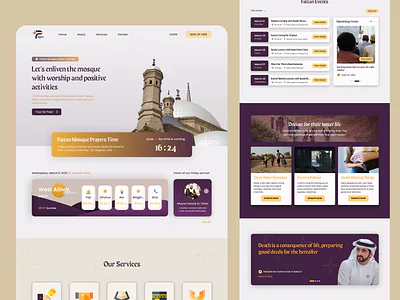In the digital age, a well-designed website is essential for masjids to engage with their communities effectively. Websites for mosques serve as portals for information, communication, and outreach, making it crucial to stay updated with the latest trends in website design. Here, we explore the top trends in website design for masjids and how they can enhance online engagement.
Responsive and Mobile-First Design
Importance of Mobile Accessibility
With the increasing use of smartphones, having a mobile-friendly website is no longer optional. A responsive design ensures that the mosque’s website is accessible and functional on various devices, including smartphones and tablets. This is crucial as many community members may rely on their mobile devices to access information about prayer times, events, and announcements. A mobile-first approach to website design for mosques ensures that the site is optimized for smaller screens, providing a seamless user experience.
Benefits of Responsive Design
Responsive design enhances user engagement by providing a consistent experience across all devices. It also improves the website’s search engine rankings, as search engines prioritize mobile-friendly sites. By ensuring that the website is easily navigable and visually appealing on all devices, masjids can reach a wider audience and keep their community members informed and engaged.
Integration of Multimedia Elements
Use of High-Quality Images and Videos
Incorporating high-quality images and videos can significantly enhance the visual appeal of a mosque website. Photos of community events, educational programs, and the masjid itself can create a welcoming and relatable online presence. Videos, such as sermons, lectures, and event highlights, can provide valuable content that community members can access at their convenience.
Benefits of Multimedia Integration
Multimedia elements can make the website more engaging and informative. Videos can be particularly effective for conveying messages and sharing experiences, while images can help to personalize the website and make it more inviting. By integrating multimedia content, masjids can create a dynamic and interactive online environment that fosters a sense of connection and community.

User-Friendly Navigation and Layout
Simplified Menu Structures
A clear and intuitive navigation structure is essential for any website. Simplified menu structures help users find the information they need quickly and easily. For websites for mosques, this might include sections for prayer times, events, educational resources, and donation options. An organized layout with logical categorization ensures that visitors can navigate the site without confusion.
Enhancing User Experience
User-friendly navigation and layout enhance the overall user experience, making it more likely that visitors will stay on the site longer and return in the future. Easy access to important information, such as mosque fundraising ideas, event calendars, and contact details, can improve community engagement and participation.
Community Interaction and Engagement Tools
Online Donation and Fundraising Platforms
Integrating online donation platforms is a key trend in website design for masjids. These tools allow community members to make contributions easily and securely. Including options for one-time donations, recurring donations, and specific campaigns can cater to different donor preferences. Additionally, promoting masjid fundraising flyers and events through the website can boost fundraising efforts.
Interactive Features
Interactive features, such as live chat support, discussion forums, and event registration forms, can enhance community interaction. These tools enable real-time communication and engagement, allowing community members to ask questions, share ideas, and participate in mosque activities from anywhere.
Emphasis on Security and Privacy
Ensuring Data Protection
As websites handle sensitive information, such as personal details and financial transactions, security and privacy are paramount. Implementing robust security measures, including SSL certificates, secure payment gateways, and data encryption, can protect users’ information and build trust.
Compliance with Privacy Regulations
Compliance with privacy regulations, such as GDPR, ensures that the mosque respects users’ rights and handles their data responsibly. Clear privacy policies and transparent data handling practices can reassure visitors that their information is safe and respected.

SEO and Content Marketing Strategies
Optimizing for Search Engines
Search engine optimization (SEO) is crucial for improving the visibility of the mosque’s website. By optimizing content with relevant keywords, such as “website design for mosques” and “biggest masjid in USA,” masjids can attract more visitors and increase their online presence. SEO best practices include using descriptive titles, meta descriptions, and alt text for images.
Content Marketing
Regularly updating the website with valuable content, such as blog posts, newsletters, and educational articles, can keep the community engaged. Topics can range from mosque fundraising ideas to Islamic teachings and community stories. High-quality content not only provides value to visitors but also improves the site’s SEO performance.
Conclusion
Staying updated with the latest trends in website design for masjids is essential for enhancing online engagement and fostering a strong community connection. By implementing responsive design, integrating multimedia elements, ensuring user-friendly navigation, and leveraging interactive tools, mosques can create dynamic and engaging websites. Prioritizing security, privacy, and SEO further enhances the website’s effectiveness in serving the community. As masjids continue to embrace these trends, they can better support their community through halal outreach and strengthen their online presence.



